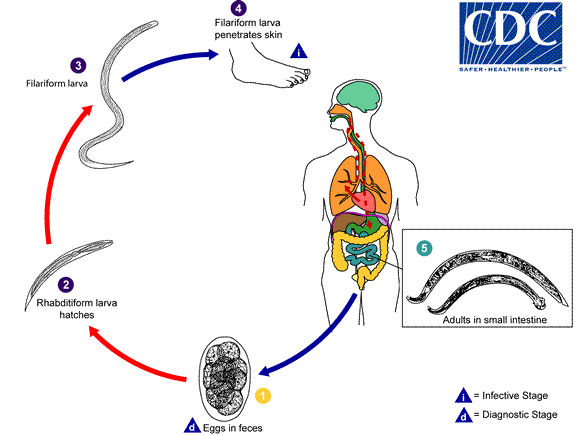Ancylostoma braziliense: Difference between revisions
| Line 41: | Line 41: | ||
{{PBI|Ancylostoma braziliense}} | {{PBI|Ancylostoma braziliense}} | ||
:* '''Cutaneous larva migrans treatment'''<ref>{{Cite web | title = Parasites - Zoonotic Hookworm | url = http://www.cdc.gov/parasites/zoonotichookworm/health_professionals/index.html}}</ref> | :* '''Cutaneous larva migrans treatment'''<ref>{{Cite web | title = Parasites - Zoonotic Hookworm | url = http://www.cdc.gov/parasites/zoonotichookworm/health_professionals/index.html}}</ref> | ||
::* 1.1 | ::* '''1.1 In adults''' | ||
:::* Preferred regimen: [[Albendazole]] 400 mg PO qd for 3-7 days | :::* Preferred regimen: [[Albendazole]] 400 mg PO qd for 3-7 days | ||
:::* Alternative regimen: [[Ivermectin]] 200 mcg/kg PO qd for 1-2 days | :::* Alternative regimen: [[Ivermectin]] 200 mcg/kg PO qd for 1-2 days | ||
::* 1.2 | ::* '''1.2 In children''' | ||
:::* Preferred regimen: [[Albendazole]] > 2 years then 400 mg PO qd for 3 days | :::* Preferred regimen: [[Albendazole]] > 2 years then 400 mg PO qd for 3 days | ||
:::* Alternative regimen: [[Ivermectin]] > 15 kg give 200 mcg/kg single dose | :::* Alternative regimen: [[Ivermectin]] > 15 kg give 200 mcg/kg single dose | ||
Revision as of 15:55, 11 August 2015
| style="background:#Template:Taxobox colour;"|Ancylostoma braziliense | ||||||||||||||
|---|---|---|---|---|---|---|---|---|---|---|---|---|---|---|
| style="background:#Template:Taxobox colour;" | Scientific classification | ||||||||||||||
|
Editor-In-Chief: C. Michael Gibson, M.S., M.D. [1]; Associate Editor(s)-in-Chief: Tamar Sifri [2]
Overview
Ancylostoma braziliense is a species of Ancylostoma.
It can cause creeping eruption.[1][2]
Life Cycles
Intestinal Hookworm Infection: Eggs are passed in the stool (1), and under favorable conditions (moisture, warmth, shade), larvae hatch in 1 to 2 days. The released rhabditiform larvae grow in the feces and/or the soil (2), and after 5 to 10 days (and two molts) they become filariform (third-stage) larvae that are infective (3). These infective larvae can survive 3 to 4 weeks in favorable environmental conditions. On contact with the human host, the larvae penetrate the skin and are carried through the blood vessels to the heart and then to the lungs. They penetrate into the pulmonary alveoli, ascend the bronchial tree to the pharynx, and are swallowed (4). The larvae reach the small intestine, where they reside and mature into adults. Adult worms live in the lumen of the small intestine, where they attach to the intestinal wall with resultant blood loss by the host (5). Most adult worms are eliminated in 1 to 2 years, but the longevity may reach several years. Some A. duodenale larvae, following penetration of the host skin, can become dormant (in the intestine or muscle). In addition, infection by A. duodenalemay probably also occur by the oral and transmammary route. N. americanus, however, requires a transpulmonary migration phase.
-
Life cycles of Ancylostoma braziliense
Adapted from CDC
-
Micrograph of Ancylostoma duodenale hookworm's (125X mag). From Public Health Image Library (PHIL). [3]
-
Ancylostoma braziliense mouth parts. From Public Health Image Library (PHIL). [3]
-
Hookworm egg undergoing the process of cellular division. From Public Health Image Library (PHIL). [3]
Treatment
Antimicrobial Regimen
- Ancylostoma braziliense
Return to Top
- Cutaneous larva migrans treatment[4]
- 1.1 In adults
- Preferred regimen: Albendazole 400 mg PO qd for 3-7 days
- Alternative regimen: Ivermectin 200 mcg/kg PO qd for 1-2 days
- 1.2 In children
- Preferred regimen: Albendazole > 2 years then 400 mg PO qd for 3 days
- Alternative regimen: Ivermectin > 15 kg give 200 mcg/kg single dose
- Note: Albendazole is contraindicated in children younger than 2 years age
References
- ↑ Shinkar RM, Stocks R, Thomas E (2005). "Cutaneous larva migrans, creeping eruption, sand worm". Arch. Dis. Child. 90 (10): 998. doi:10.1136/adc.2005.073197. PMC 1720113. PMID 16177155. Unknown parameter
|month=ignored (help) - ↑ Tierney, Lawrence M.; McPhee, Stephen J.; Papadakis, Maxine A. (2008). Current medical diagnosis & treatment, 2008. McGraw-Hill Medical. p. 1323. ISBN 0-07-149430-8.
- ↑ 3.0 3.1 3.2 "Public Health Image Library (PHIL)".
- ↑ "Parasites - Zoonotic Hookworm".

![Micrograph of Ancylostoma duodenale hookworm's (125X mag). From Public Health Image Library (PHIL). [3]](/images/6/6b/Ancylostoma_braziliense05.jpeg)
![Ancylostoma braziliense mouth parts. From Public Health Image Library (PHIL). [3]](/images/4/4e/Ancylostoma_braziliense04.jpeg)
![Hookworm egg undergoing the process of cellular division. From Public Health Image Library (PHIL). [3]](/images/9/92/Ancylostoma_braziliense01.jpeg)